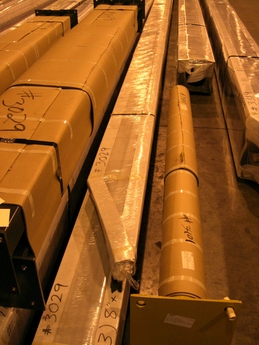Gift wrapped for the end user
17 December 2007It's a time of year when some of us will soon be wrapping gifts for friends and loved ones in preparation for Christmas. But the way crane parts and lifting gear is packed for shipment should also be given consideration. And it would be a wise resolution for 2008 to improve the way you package your products.
Some people take time and effort to neatly fold every corner of their wrapping paper and even put ribbons and bows on their presents, even though the ungrateful recipient is just going to rip it off and discard it thoughtlessly to the floor. Not the gift, the paper.

When preparing, say, a jib crane for shipment, the packaging is far more than just decoration, it is protection for the product and its parts.
A crane can be bumped around during transportation and there's nothing worse for an end user than to take delivery and find that their shiny new, usually yellow, crane has flecks of paint missing or is even damaged. Imagine how poorly this reflects on the manufacturer or supplier.
The scenario is especially worth baring in mind when shipping by LTL (less than truckload), as many of you do.
So much care is taken during the manufacture and testing of lifting products, but it should go one step further.
I had the pleasure of visiting Morgantown, Pennsylvania-based firm Spanco Inc. on a recent trip to the States, and it was great to witness the care and attention put into preparing products for shipment.
Spanco, a major manufacturer of jibs, gantries, workstations and rigid track fall protection systems, has invested in a stretch-wrapping system. It wraps cranes once they have been cleaned and painted, before being loaded onto trucks for transportation.
The process can be done either by hand or by machine, depending on the product and size of part. Workstation cranes, for example, are always run through the machine, while larger jibs have to be wrapped by hand.
After the product is wrapped, it is stacked and 1/16in micro-foam is used between the pieces, for example, trusses in the case of bridge cranes. Measurements are taken and corner boards made of heavy duty cardboard are then placed on all of the corners. The finished wrapped product is banded together with steel bands and then skidded for shipment.
Packing time depends on the product type and size. A standard workstation bridge crane can be packaged via the wrapping machine in 20 minutes or less. A larger product that requires hand wrapping can take much longer, up to an hour to measure for cardboard corners, and then wrap. But it's worth it...
The result has been that, in line with ISO guidelines, "paint damage comments are down to almost zero," according to Spanco.
It explains: "With each shipment that goes out, we place a comment card and every single comment, whether positive or negative, is logged for ISO purposes. Comments may come back via the comment card, postal mail, email, or phone. The logged comments are then reviewed at quarterly management meetings. Every single comment is reviewed and addressed."
As Spanco pointed out: "What better value is there to a business than a satisfied customer?" They have a point.
How important is packing to you?
I'd like to hear from some end users regarding the condition of the cranes they purchase when they arrive on site.
Keep in touch,
Richard Howes, Editor